August 17, 2010 — An 'original' Mercury astronaut and a spacecraft set to orbit the planet Mercury will be featured on two United States postage stamps to be released next year, according to the U.S. Postal Service.
Alan Shepard, who became the first American in space 50 years ago next May, will be honored together with NASA's MErcury Surface, Space ENvironment, GEochemistry and Ranging, or MESSENGER, probe, which is scheduled to begin orbiting the planet closest to the Sun in March 2011. The two stamps, which will be offered as an attached pair referred to as a "se-tenant," are tentatively scheduled for release in the spring.
Titled "Alan Shepard: First American in Space" and "First Spacecraft to Orbit Mercury," the commemoratives will be designed by former Air & Space magazine art director Phil Jordan and science fiction/fantasy artist Donato Giancola based on NASA imagery.
The Postal Service announced the two space stamps, as well as 67 other stamps planned for 2011, at the American Philatelic Society Stamp Show held last week in Virginia, according to the stamp collecting newspaper Linn's Stamp News and the website, VirtualStampClub.com.
First astronaut on a U.S. stamp
Alan B. Shepard, Jr., who in addition to flying onboard the 1961 Mercury-Redstone 3 suborbital mission was the fifth man to walk on the Moon (and the first to hit golf balls off it), will be the first American astronaut to be honored on a U.S. stamp.
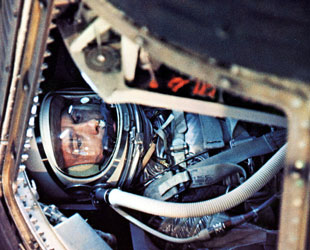
Alan Shepard inside his Freedom 7 capsule prior to becoming the first American in space. (NASA/Retro Space Images) |
Since the early 1970s, U.S. stamp selection criteria have required an individual be deceased at least five years prior to their being eligible for consideration. Further, events of "historical significance" are limited for commemoration on anniversaries in multiples of 50 years.
Shepard died of leukemia at age 74 in July 1998. Although he was not the first astronaut to pass away, his first flight is the first U.S. manned mission to reach 50 years.
Previous U.S. stamps have depicted scenes from NASA's manned missions including a 1967 issue showing the first American spacewalk and a 1969 commemorative honoring the "First Man on the Moon," but neither explicitly named their depicted subjects as Ed White or Neil Armstrong. In addition, to date all astronauts appearing on stamps have been illustrated wearing their spacesuits, their face hidden by their helmets' visors.
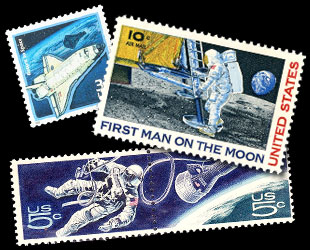
Previous U.S. stamps have commemorated manned missions without explicitly naming the astronauts involved. (USPS) |
A stamp issued in 2000 came close to honoring another of Shepard's peers. Released as a part of the "Celebrate the Century" series as a result of the public voting to include Mercury astronaut John Glenn's 1998 space shuttle flight as one of the highlights of the 1990s, it avoided breaking the rules by depicting the Senator's spacecraft rather than the man himself with only the words, "Return To Space."
A similar approach was employed for the 4-cent "Project Mercury" stamp that was produced in secret and released to celebrate Glenn's first return from space. Released on February 20, 1962 within minutes of Glenn's splashdown, the stamp's illustration was of a Mercury capsule in orbit.
Third stamp for Mercury-bound spacecraft
The 2011 MESSENGER-themed "First Spacecraft to Orbit Mercury" stamp will mark the third time the Postal Service has chosen to commemorate a mission studying the 'first rock from the Sun.'
The first such stamp was released in April 1975, depicting NASA's Mariner 10 spacecraft. Departing Earth two years earlier as the seventh and last probe in its series, Mariner 10 was the first spacecraft to visit Mercury.
The unmanned spacecraft made three flybys of the small, rocky planet between March 1974 and March 1975.
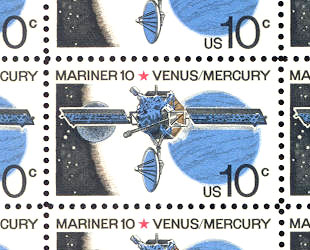
1975 "Mariner 10 Venus/Mercury" postage stamp (USPS) |
The stamp, issued just a few weeks after the spacecraft's final encounter with the planet, showed Mariner 10 nearing Venus with Mercury in the background. Mariner 10 was the first probe to use a "gravitational slingshot," employing Venus' pull to accelerate it towards Mercury. It was also the first mission to visit two planets.
Mariner 10 graced a second stamp 16 years later as part of a "Space Exploration" series that featured one design for each planet in the solar system. Each 29-cent stamp depicted the planet being visited by a robotic probe (all but Pluto that is, which was included in the set but as noted on the stamp was "Not Yet Explored").
Until MESSENGER launched on Aug. 3, 2004, Mariner 10 was the only probe to be sent to Mercury, hence the U.S. Postal Service recycling the mission for another stamp.
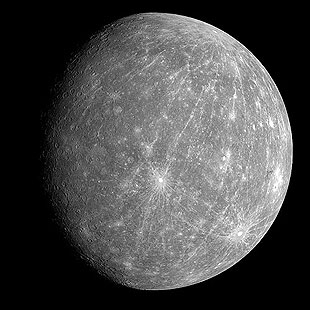
Planet Mercury, as captured by MESSENGER in October 2008 during its second of three flybys before entering orbit. (NASA) |
If all proceeds to plan, MESSENGER will become the first spacecraft to enter orbit around Mercury (as the title of its 2011 stamp proclaims) on March 18, 2011. To get there, MESSENGER has to date made one flyby of Earth, two flybys of Venus, and three flybys of Mercury.
First space stamps in more than a decade
The U.S. Postal Service and the Citizens' Stamp Advisory Committee, which is tasked with evaluating the merits of all stamp proposals, last chose to commemorate space exploration in July 2000 with 15 different stamps themed to "Space Achievement." Issued together as a poster, the set included the United States' first pentagonal and round stamps as well as the first holographic stamp.
Since then, the closest the Postal Service has come is a March 2008 stamp honoring astronomer Edwin Hubble as part of an ongoing series dedicated to American scientists (in 2011, four stamps will feature chemist Melvin Calvin, botanist Asa Gray, physicist Maria Goeppert Mayer, and biochemist Severo Ochoa de Albornoz).
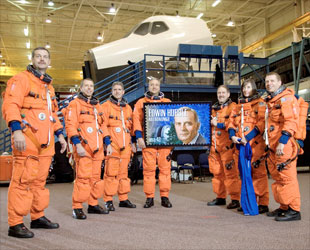
Space shuttle Atlantis' STS-125 astronauts help reveal the 2008 U.S. stamp honoring astronomer Edwin Hubble. (NASA) |
Hubble is perhaps best recognized as the namesake for the space telescope and the astronauts who flew the final space shuttle mission to service the observatory took part in the stamp's unveiling.
Unlike the United States, many other countries released in 2007 stamps to commemorate the 50th anniversary of the start of the space age and the launch of the first satellite.
At least two foreign postal services, Ascension Island and Monaco, issued postage stamps commemorating NASA's 50th anniversary in 2008.
